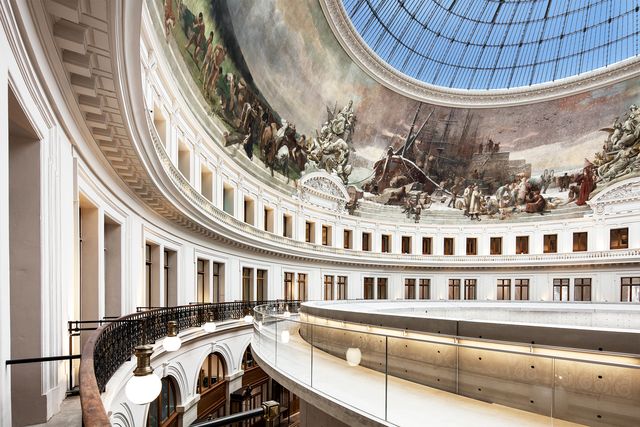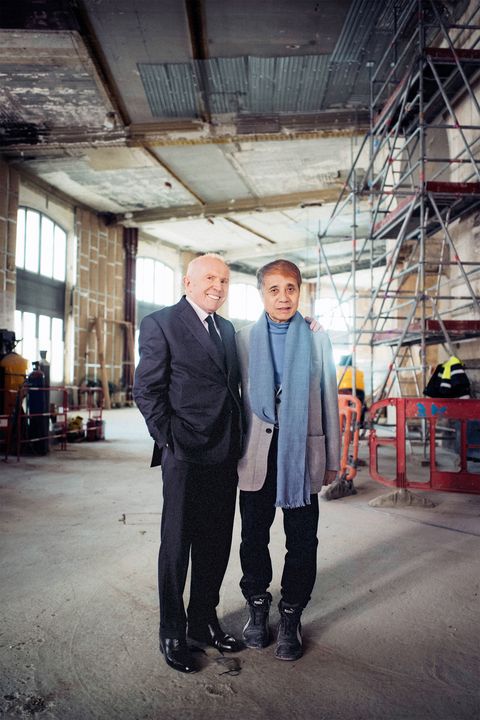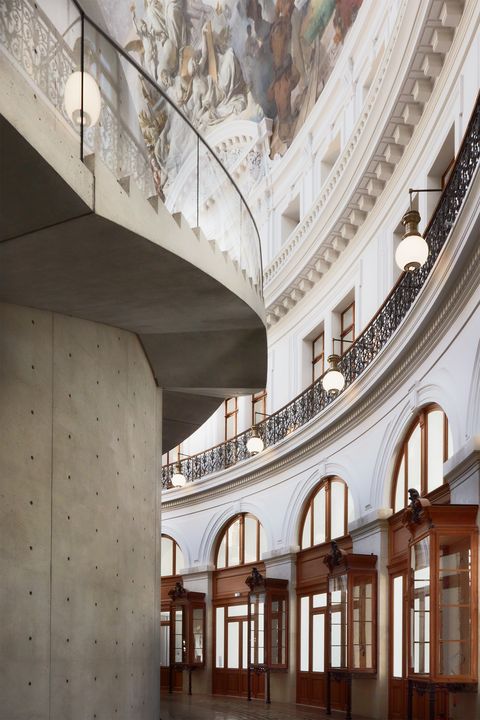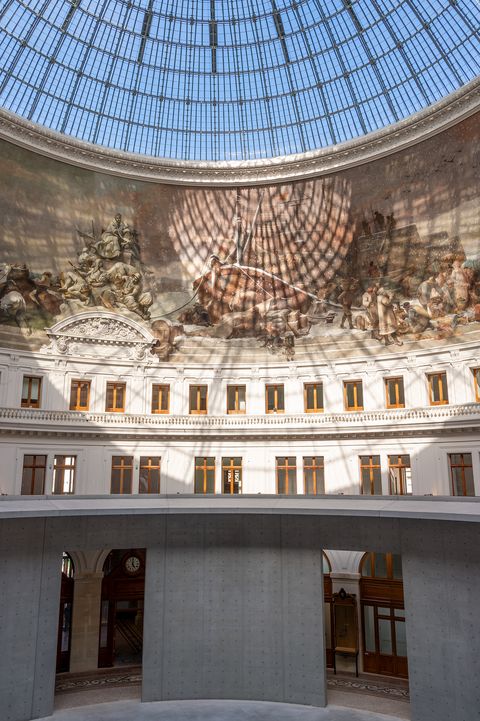Make Room, Mona Lisa—Paris Welcomes a New Museum
Bourse de Commerce—located in a historic building that has been exquisitely reimagined by the architect Tadao Ando and housing works from the legendary collection of François Pinault—opens on May 22.
For years, the French billionaire François Pinault has kept the details of his Paris project, at the Bourse de Commerce on the Right Bank of the French capital, under lock and key. Journalists (including yours truly) had been ordered not to reveal any specifics about the collection of contemporary art it will soon display, which—in the age of Instagram—is meant to remain a secret. But the collection’s long-delayed opening, now scheduled for May 22, faces a bigger challenge than preserving the element of surprise. The Bourse de Commerce is opening in the Covid era, when the future of museums in general is more uncertain than ever before. Keeping secrets is one thing; putting a museum on the map is another. But if anyone can pull it off, it is probably Pinault.
At 84, he almost needs no introduction. A quick run-through: He started in the timber industry in the mid-1960s, but his business dealings eventually brought him into luxury goods. Kering, his holding company, owns some of the most storied brands in the business, including Gucci, Yves Saint Laurent, Alexander McQueen, and Balenciaga. With an estimated net worth of about $45 billion, he is also a leading philanthropist, financing, among other things, the restoration of the writer Victor Hugo’s house on the island of Guernsey and, along with his great rival and fellow French billionaire, Bernard Arnault, pledging millions of euros to restore Notre-Dame, following the devastating 2019 fire.
To say he is also a legendary collector of contemporary art would be a cliché, but unfortunately “legendary” is the most succinct way of describing the obvious reality. His passion and breadth as an aesthete are essentially unmatched in his generation. “He collects first with his eyes—he makes a point of really seeing with his eyes,” says Luc Tuymans, the acclaimed Belgian visual artist whom Pinault has collected for nearly 25 years. “But he collects in a certain depth with artists. It meant a great deal to my livelihood, yes. But to have someone appreciate the work means so much—it’s not just an anonymous relationship.”
Apart from his philanthropic undertakings, most of Pinault’s projects to date have been focused outside his native country. The theme of restoration is central to them all; his passion for contemporary art is matched by his passion for revitalizing venues that are anything but contemporary. He has renovated and restored crumbling landmarks in Venice, including the Palazzo Grassi and its theater on the Grand Canal, and the Punta della Dogana, the 17th-century customs house at the tip of the Dorsoduro sestiere, where the Grand Canal meets the Giudecca Canal. For each of these ventures Pinault enlisted the Japanese architect Tadao Ando to reconfigure the space, blending clean lines into the existing architecture. The Bourse de Commerce, Pinault’s $170 million Paris homecoming, is a similar project. It is the opening of a forgotten space at least as much as of a celebrated collection.
Like its Venice counterparts, Pinault’s Paris project is awash in history. Each chapter of modern Paris’s story has left its mark on the round structure that stands today. Pinault’s ambition is to complement the other cultural landmarks around his namesake museum, not outshine them. “Near here there’s a great museum, the Louvre, which I’m not going to try to imitate. That would be pretentious,” he told the New York Times last year. “And not far away there’s the Pompidou Center, a great museum of the 20th century.” As for his own project, he sees it as “an interesting complement” to those older, more imposing collections.
In the 16th century the first plot of land now covered by the Bourse de Commerce was used to build an hôtel particulier for Catherine de Medici, the longtime queen consort of France. All that remains of that initial period is the so-called Medici column in front of the building. In the late 18th century, the city erected a circular building on the site of the old Medici mansion for a grain exchange, setting a template that has been preserved ever since. A wooden dome destroyed in a fire was replaced by an iron dome, an addition that drew its share of criticism at the time. In his 1831 novel, Notre-Dame de Paris, Hugo poked fun at the building: “The dome of the Halle au Blé is an English jockey cap on a large scale.”
The 19th century left its mark on the Bourse de Commerce as well, perhaps the most delightful of all. In the central rotunda Ando’s concrete wall creates a passageway, complete with vitrines that Pinault has repurposed to display objects from his collection, that is reminiscent of an old arcade. Immortalized by the philosopher Walter Benjamin, the arcade is the very essence of Paris in the long 19th century, when industrialization transformed the city into an urban tableau of bourgeois fantasy. The arcade was where citizens became consumers, self-actualizing in their reflections in the window and tortured by objects that were just a bit out of reach. The Pinault collection reinvents this most Parisian of forms with a little less angst: You are free to browse, and there’s more to see than your own reflection.
But the project here is a revival, not merely a restoration. Pinault’s signature is to refit historic spaces with modern architectural details, and once again he has turned to Ando, whose austere concrete slabs are both the antithesis and a natural continuation of the aesthetic of the Bourse de Commerce, filled as it is with overlaid architectural styles from various eras. Ando has designed a cylindrical wall that encircles the rotunda and ascends toward its peak. “By nesting new spaces within it, while respecting the memories of the city engraved in its walls, I will transform the building’s entire interior into a space for contemporary art,” he said. “The theme here, once again, is to create a building that connects the past with the present and the future.”
In the context of contemporary art collections—and even other Pinault collections—art soon to be on display will be a welcome departure, and it will change regularly. For the opening, the initial exhibition focuses on artists whose work addresses themes central to the most urgent conversations on both sides of the Atlantic today, including the history of discrimination and the value of Black life.
This is nothing short of daring in France, an officially colorblind society in which the state prohibits the collection of statistics on race, ethnicity, or religion and which often struggles to address issues of systemic racism, especially in police forces. France is a “universal” republic, meaning that all citizens are equal in the eyes of the law, and citizens are meant to transcend their particular identity groups, whatever those may be, and see themselves as citizens first. Because of the legacy of World War II, when the French authorities rounded up Jewish citizens for persecution and deportation, the government is hesitant to draw distinctions between citizens of any kind.
But while France refuses to recognize race as a concept, racism persists, a problem that many French citizens of color say there is no proper language—not to mention willingness—to describe. Many hope that, with the opening of the Pinault museum, there will be a public forum in which to confront these issues in a glittering capital that often seems to look the other way. T&C has agreed not to reveal any details, but among the collection’s highlights are a number of works by notable young Black artists who grapple with the legacies of slavery, colonialism, and discrimination. The galleries of the Bourse de Commerce are bound to be a meeting place for the ongoing conversation about race, identity, and coming to terms with the meaning of each.
Unfortunately, the long-awaited Pinault collection will open to the public before the end of the coronavirus pandemic. In France museums have been shuttered for months—even while department stores and offices have been allowed to reopen. The question is how the experience will change when they do reopen. Paris will have fewer tourists, and even locals eager to see art will be coming from a different place, beleaguered by more than a year of isolation and fear of a virus whose full characteristics remain unknown. “To open now has to mean changing your perspective, thinking differently about what matters, and about a much more local audience,” says Joanne Heyler, founding director of the Broad Museum in Los Angeles. “There may be advantages in this. A new museum can take some time to come into its own before tourism is back in full, and it can more intimately address the city in which it is based. Big parties for the global art world can come in time.”
The Pinault collection will be a significant addition to a city in which most major museums are still run by the state. On the western periphery of Paris there is the Louis Vuitton Foundation, designed by Frank Gehry, the signature cultural project of Arnault, Pinault’s rival. But in the middle of a changed city, the Bourse de Commerce will provide a welcome means of escape. The collection will change seasonally, with works from different countries and different contexts cycling in and out of the sizable but not cavernous space. But there is one thread that unites these otherwise disparate elements into a unified whole. Luc Tuymans puts it this way: “The essence of the collection is actually one person, which is François Pinault.”
A version of this story appears in the April 2021 issue of Town & Country.






No comments:
Post a Comment